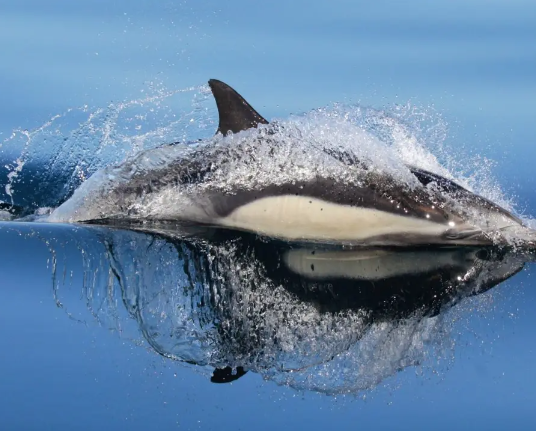
Dolphins in waters around the United Kingdom have faced mounting pressure from chemical pollution over the past few decades. Many short-beaked common dolphins have washed ashore, and reports show they carried worrying levels of toxins in their tissue.
Rosie Williams, a researcher at the Zoological Society of London, noted that once-banned chemicals and changing sea temperatures could be adding to these animals’ health troubles.
In particular, researchers have pointed to shifts in the water’s characteristics and high burdens of polychlorinated biphenyls (PCBs).
How chemicals and heat harm dolphins
PCBs were widely used in manufacturing for a long time. In the 1980s, officials in the U.K. decided these chemicals were too dangerous and outlawed them because of their toxic nature.
Despite that move, it seems that residues of these compounds are still entering the ocean. Some experts believe that old industrial sites leak traces into waterways, and these flows eventually reach marine habitats.
In the meantime, sea surface temperatures appear to be edging higher in parts of the U.K. This warming of the water can put stress on many species, including dolphins that rely on stable conditions for feeding and other life processes.
Dolphins suffer from toxins
Short-beaked common dolphins rank high up in food chains, which makes them prone to storing more toxins in their bodies. Many fish at lower levels carry smaller amounts of these compounds, but dolphins can accumulate bigger doses by eating prey that has already absorbed contaminants.
“Their position at the top of the food web means that toxins from their prey accumulate in their blubber, providing a concentrated snapshot of chemical pollutants in the ocean – though unfortunately at the expense of their health,” said Thea Taylor, managing director of Sussex Dolphin Project.
When PCBs gather in the fatty tissues of these animals, trouble can follow. According to researchers, these toxins might hurt dolphins’ immune systems, leaving them more vulnerable to various infections.
Chemical damage in stranded dolphins
In an effort to pinpoint the causes of their deaths, experts analyzed data from short-beaked common dolphins that were found stranded on U.K. shores. The findings revealed a worrying connection between PCB levels and mortality from infectious diseases.
The researchers noted that every slight rise in PCB load carried a higher chance of fatal infections. They also found that spikes in sea temperatures often matched a jump in disease risk.
Some of these illnesses included gastritis, enteritis, bacterial complications, and pneumonia. In many cases, they turned fatal once the dolphins’ immune defenses weakened.
The role of water temperatures
Scientists suggest that warmer waters might also shift prey distributions. That could complicate the dolphins’ feeding patterns, leaving them in worse shape and more likely to get sick.
Some experts worry that higher temperatures might boost the activity of disease-causing organisms in the ocean. If pathogens grow faster, dolphins become more likely to encounter them.
Taken together, these factors seem to form a harmful cycle: weaker dolphins, more pathogens, and chemicals that make everything worse. A multi-layered plan is needed to address all these pressures at once.
Old chemicals still pollute waters
Even though PCBs were banned in the U.K. more than 40 years ago, they remain a concern. They have a tendency to cling to sediment and can linger in the environment for very long periods.
Certain manufacturing processes still lead to trace amounts of PCBs that find their way into water. Regulators face a tough challenge in tightening controls and removing older sources of these chemicals.
Rosie Williams has pointed out that these persistent compounds keep surfacing in new samples. Some are found in estuaries or coastal areas where industrial runoff takes a toll.
A call for protective measures
Marine biologists often describe neurotoxins, heavy metals, and chemical pollutants in ocean waters as forces that aggravate existing threats. A rise in sea temperature comes on top of everything else, stacking stress upon stress.
“The ocean is facing ‘a triple planetary crisis’ – climate change, pollution and biodiversity loss – but we often look at threats in isolation,” said Williams.
She and her fellow authors believe that better management of industrial waste and more effective water treatment will help break this cycle.
Tackling ocean chemicals to save dolphins
Environmental groups have tried to remove contaminated sediments through dredging in certain places. Others hope to enhance filtration techniques so persistent chemicals get trapped before they spread any further.
Experts also note that PCBs are not the only cause for concern. Similar substances, like perfluoroalkyl and polyfluoroalkyl substances (PFAS), also carry toxic effects that might harm both wildlife and people if not regulated.
“While we cannot reverse the contamination that has already occurred, it is critical to prevent further chemical inputs into the environment,” said Taylor.
Dolphin health shows marine future
Many researchers agree that dolphins serve as a valuable bellwether for ocean health. If top predators suffer, it can reflect risks to smaller organisms and ultimately to human communities too.
Environmental scientists have stressed that these findings should guide policies for marine protection. Even though we cannot simply erase toxins already in the waters, curbing any additional discharge might limit the damage over time.
Reducing chemicals for dolphin survival
Going forward, experts will determine which regions have the highest levels of PCB pollution. Some areas may need urgent interventions, especially if incidents of dolphin stranding keep increasing.
Ecosystems are complicated, and climate shifts could spark changes that no one has fully predicted. Observers hope that early and decisive action will give marine life a chance to adapt without getting overwhelmed by chemical burdens.
Article Credit: earth